Cape Fear’s
Going Green
Green Jobs Act
Coastal Carolina Shorebirds
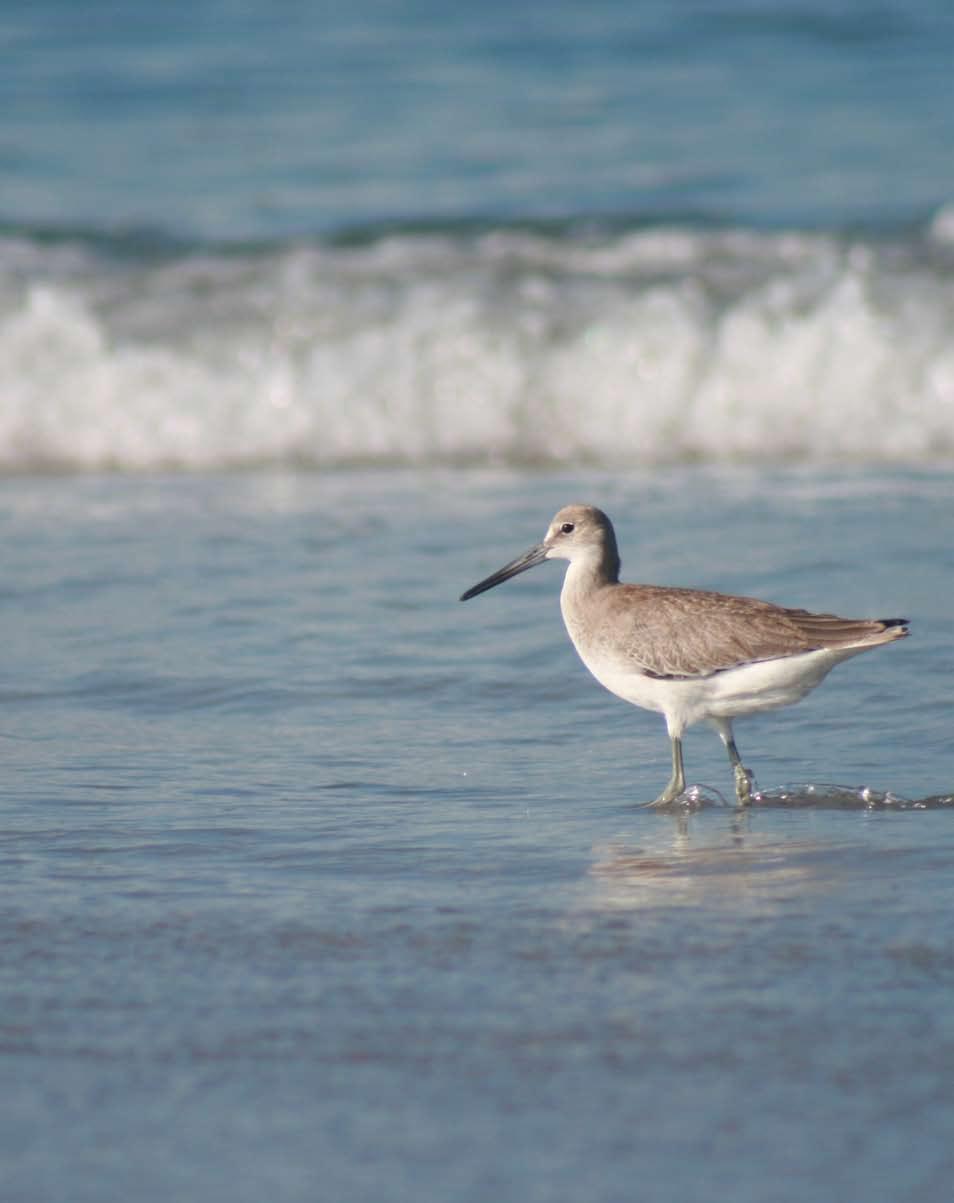
Hold a Waste-Free Picnic
Stormwater 101
Life on the Edge: Ocean Exploration
— Deep Sea Coral Reefs
— Plastics in Our Oceans
Letter from the Editor
As I reviewed material for this issue, I was struck by how far Wilmingtonians go in their pursuit of environmental activities, figuratively as well as geographically. Our biologists take time to educate about the treasures of our natural world. Our scientists, doctors, and citizens make sure we consider our natural environment as we make long-term business and development choices. Marine biologists team with others to study deep water coral reefs off Florida or travel the Atlantic and Pacific Oceans to assess the massive amounts of plastic refuse working their way down the water chain.
Here at home we continue to work, individually and in groups, to clean up our neighborhoods and waterways, to protect the special environments of the animals around us…and us. We are truly rethinking our impact on the world around us.
I visited Oregon again—having fun learning first-hand how to put on a low-waste cookout (see p. 7-8 for ideas), create a community garden, and minimize pesticide use. It also gave me a chance to visit with Skip Wentz, our Ecological House columnist, who lives in Corvallis.
As our national dialogue turns more to sustainability and the creation of lasting jobs, I’m heartened to see local people finding creative ways to get involved. Individuals are starting new businesses, providing everything from diapers for the “green” baby to consulting services for companies wanting to increase their “green-ness.” We’re getting more sophisticated about recycling: artists helping us rethink re-use, inventors coming up with more cost-efficient bundling of aluminum cans. We’re all rethinking our environment, scientists and citizens alike.
New this issue: The first in our “Stormwater 101” series, by Jennifer Butler, Stormwater Education Program Coordinator for the City of Wilmington. And we provide links that allow a connection with exciting ventures like Jay DeChesere’s green renovation, Doug Ross’ underwater expeditions, and Bonnie Moneteleone’s adventures aboard the Alguita; their blogs and video clips let you track their progress as it happens.
I hope you’re able to get out and enjoy the end of summer—and watch closely, with us, for transitions—as we move into fall, and move in new and sustainable directions.
Valerie L. Robertson EditorContents
3 Shorebirds of Southeastern North Carolina
4 Community Clean-ups
5 Plastics in Our Oceans
7 Stormwater 101 The Basics of Stormwater
8 News from Our Sister Green City, Eugene Oregon Sustainable Picnics!
10 Ocean Exploration Deep Sea Coral Reefs
14 Green Jobs Act Closer to Reality
16 Oyster Reef Rebuilding Brings Coastal Jobs
17 Local Green Building News
18 Canstruction® 2009 Comes to Wilmington
19 Business News
21 Local Food
21 Artistic Recycling and Re-use
22 Your Ecological House The Battle of the Lawn
23 Shorebirds
24 Pedaling for Peanuts
Front Cover: The Willet is an inconspicuously colored bird, until it opens its wings and displays streaks of black and white—some on the wing top, and covering the entire underside of the wing. Photo was taken on the South end of Wrightsville Beach.
Cape Fear’s Going Green is a quarterly publication promoting eco-friendly resources and lifestyles in the Lower Cape Fear River Basin.
Publisher & Editor in Chief: Valerie Robertson
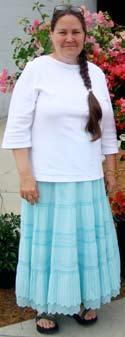
Sister City: Eugene, Oregon (Voted “Greenest City” 2006 by The Green Guide) Eugene Contributing Editor: Mary Robertson
Advisors & Editorial Contributors: Joe Abbate, Liz Baird, Courtney Bowman, Jennifer Butler, Adam Fenwick, Austin Fenwick, Randall G. Flood, Kate Gernaat, Alysoun House, Art Howard, Rusty Ingold-Smith, Ray Ketcham, the Kuuskoski family, Bonnie Monteleone, Jennifer O'Keefe, Scott Ogden, Christie Perry, Cary Ralston, Adeline Robertson, Philip S. Wenz & Kevin Wick.
Cape Fear’s Going Green
Going Green Publications
P. O. Box 3164
Wilmington, NC 28406 (910) 547-4390
www.goinggreenpublications.com
Cape Fear’s Going Green is available by subscription or on our Web site. Print copies are available at more than one hundred area eco-friendly businesses and locations, including:
Angela’s Pepper-Picked Foods, B + O Design Studio, Coastal Glass Tinting, The Napping Cat, Old Growth Riverwood, Old Books on Front Street, Pomegranate Books, Progressive Gardens, Sambuca, Sapona Green Building Center, Tidal Creek Co-op, UNCW, WHQR, and the Shelton Herb Farm booth at area farmers’ markets.
Going Green would like to thank the editors of Encore for picking us as a runner-up in their first Wilmington Webbie Awards competition:
www.goinggreenpublications.com
Editorial: If you have story ideas or calendar items to suggest, email us at editor@goinggreenpublications.com, or call (910) 547-4390.
Advertising information: Email ads@goinggreenpublications.com.
Cape Fear’s Going Green is distributed free through Brunswick, New Hanover, and Pender counties. If you have a business and would like to receive multiple copies for the public to pick up, please contact us.
Shorebirds of Southeastern North Carolina
Every year the Wrightsville Beach Museum of History offers a new exhibit featuring the natural world of our area. This year, the Museum collaborated with local naturalist Joe Abbate to showcase the life of shorebirds indigenous to our coastal area.
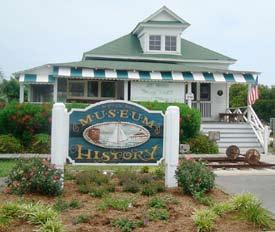
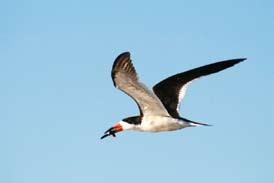
This summer’s nature exhibit at the Wrightsville Beach Museum highlights the life history of nesting shorebirds of southeastern North Carolina. By focusing on six important species, the exhibit displays educational information on species identification, threats, and conservation issues associated with these birds. The exhibit display will be supplemented by a series of educational birding (bird watching) walks and eco-tours, allowing the public to learn first-hand, from local experts, how to identify and understand shorebirds native to our area.
Our Cape Fear Region boasts a wide diversity of shorebirds and habitats that are vulnerable to many threats. Both the shorebirds and their habitats demand our recognition and conservation efforts in order to be sustained. Photographs of a colony of birds on the south end of Masonboro Island are used to illustrate the seasonal shift in shorebird habitat and the issue of bird management on local barrier islands. Home to skimmers, oystercatchers, terns and plovers—as well as non-native fox predators—Masonboro is an eightmile-long, undisturbed barrier island; it serves not only as a wildlife sanctuary, but as a prime recreation destination for boaters, surfers, campers, and beach-goers. Masonboro Island site manager Hope Sutton, of the North Carolina Coastal Reserve, says that direct human impacts are one of the biggest obstacles to shorebird conservation. Sutton asserts, “Becoming aware of how your actions impact these birds, and taking the time to educate yourself on these impacts,” is one of the most helpful things a person can do to help preserve these winged wonders.
The Wrightsville Beach Museum exhibit, coupled with the birding field-trip series, was designed to allow local naturalist and birding experts to share their knowledge of area shorebirds as well as threats our presence can introduce. This is a great opportunity for the general public to develop a stronger appreciation for these species and an awareness of what we can do to assure them a safe future.
Andy Wood, Education Director of Audubon NC, notes, “people are not generally aware that birds are using the beach and that they depend on the beach environment. Many people think that they can just fly off to nest in the woods or in other areas, but that is just not the case.” Regulating the balance between the “public’s desire to use the beach, and the birds’ need to use the beach,” has become one of the most challenging management obstacles.
Cape Fear River Watch offered a seminar on shorebirds as part of its popular First Saturday Seminar series, typically held at their headquarters location in downtown Wilmington. UNCW’s Dr. Marcel van
Tuinen spoke on shorebird diversity; avian biologist Joe Abbate presented information on local shorebirds and how to diminish threats to their local habitat. Held this time at Banks Channel Pub and Grille, the seminar allowed attendees to have lunch and then tour the newly opened exhibit at nearby Wrightsville Beach Museum.
Abbate explains his vested interest in designing this shorebird exhibit: “My main passion resides in fostering coastal environmental education programs for kids and adults, to help educate them about the rich flora and fauna diversity found on our coast.” An exciting aspect of the exhibit is that it is available to schools wanting to use the display materials for their students. Wrightsville Beach Elementary School was the first to use the displays in its curriculum.
As owner of Wrightsville Water Tours on Wrightsville Beach, and in his role as program director for Cape Fear River Watch, “Captain Joe” offers a variety of birding and eco-tours throughout the year. He is leading 90-minute tours to Masonboro Island specifically relating to this exhibit in August and September.
The museum exhibit will be on display through August, and likely well into September (call ahead to find out).
For information and reservations for birding tours during the exhibit and beyond, contact Captain Joe Abbate at captainjoe@capefearnaturalist.com or at (910)200-4002.
See page 23 for shorebird photos.
community clean-ups
Carolina Place–Ardmore Neighbors Team Up to Clean Up Wallace Park

Burnt Mill Creek runs through Wallace Park, along the eastern edge of Carolina Place. The park has playgrounds for children and room for people to stroll or exercise their dogs. The City of Wilmington Parks Department staff maintain the park, mowing, trimming, and providing and maintaining trash cans and receptacles for pet waste. But it can be a challenge to keep up with litter removal on two acres of land without the help of people who use the park. Members of the new Carolina Place–Ardmore Neighborhood Assocation (CPANA) decided to hold a creek clean-up in Wallace Park one Saturday in May.
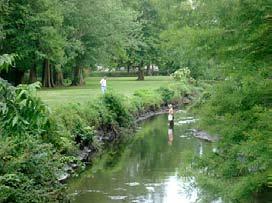
The organized portion of the cleanup was for those who wanted to work between 10 and 2, picking up litter around and in the creek. Some came out for the duration; others stopped by to help as they could. Parents brought children, and explained to them the benefits of keeping litter from going into the creek.
CPANA provided trash bags, and everyone brought their own gloves. Barbara Wilder was pleased to try out her new longhandled gripper, which she’d requested as a birthday gift.
For the informal portion of the weekend clean-up, people picked up litter in neighborhood alleyways on their own schedule, sometime through the weekend. The combination of organized and “free” clean-ups meant that anyone who wanted
Burnt Mill Creek is a tidal creek, ebbing and flowing with the tides, which helps trash migrate downstream over time. If not stopped, litter can work its way downstream to Smith Creek, and then to the Cape Fear River, and eventually out to the ocean. Here, Trivett paddles downstream to investigate trash that has migrated all the way to the Market Street bridge at the end of the park.
to help could do so, regardless of schedule. The day’s “find” included a heavy metal coffee table that had been inching its way down the creek for more than a year. Kyle Trivett retrieved both table pieces several yards south of the Market Street bridge.
Want to help? You can participate in the important work of keeping the creeks clean (and the ocean) just by picking up some litter when you take a walk, with a group or on your own. If you like to work with others, Cape Fear River Watch organizes a clean-up the 3rd Saturday of each month—no expertise required! See www.cfrw.us or call (910)762-5606 for location of their next clean-up. Or, if you’d like to help keep Wallace Park clean, neighbors are starting weekly clean-ups: email letskeepwallaceclean@gmail.com or call (910)547-4390.
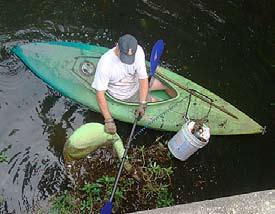
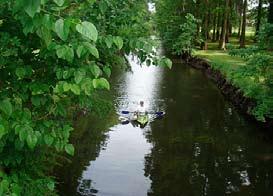
Want to tap into the Stimulus Package funds?
Have an idea...company...technology?
Experienced and Successful:
• grant writer/manager
• government contract writer/manager
• available locally
Let’s talk.
Contact Nancy Najarian on cell at 202-251-7821 or NancyNajarian@gmail.com
ocean study
Plastics in Our Oceans
by Bonnie MonteleoneIt must have been in the mid-seventies, right around age 14, when I started worrying about how my haired looked. I was looking at my reflection in our shiny metal toaster while my mother peeled the cellophane off a package of ground beef, then did the same with the Styrofoam bottom as she asked, “Where does all that plastic go?” Odd, that I would remember this moment, especially when I was preoccupied with something far more important. Thirty five years later, I found the answer in a graduate course assigned reading entitled, “Plastic Ocean,” by Susan Casey. A ginormous quantity of plastic has been found accumulating in the Pacific Ocean. According to Captain Charles Moore of the Algalita Marine Research Foundation, the North Pacific Gyre has become a giant cesspool of plastics, fittingly called the Eastern Pacific Garbage Patch, and this area is said to be twice the size of Texas. This gyre, a vortex of wind and currents, has become a conveyor belt for misguided plastics that end up in the ocean. The 10 million-square-mile gyre stirs the pot of plastic soup in a clockwise direction, circulating around a becalmed center where the plastics eventually reside in a perpetual purgatory.
Plastic does not biodegrade. It photo degrades [gets broken down into smaller compounds when exposed to sunlight] while being physically broken down by
current and wave action. It fragments into smaller particulates but it never goes away. We produce more than 60 billion tons of plastic each year, most of which is for one-time use. So for the seconds or minutes we use a plastic straw, fork, wrapper, or bottle, it will remain on this planet for half a millennium until it breaks down into smaller units of measure. Year in, year out—60 billion tons of plastics made, zero goes away.
Plastics enter our oceans via direct dumping and from cargo lost at sea, yes, but it is estimated that 60 to 80 percent
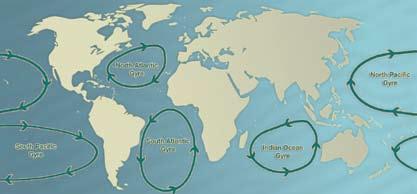
Bonnie Monteleone’s ’s blog http://www.theplasticocean.blogspot.com
Jennifer O’Keefe’s blog http://blogs.nhcgov.com/KAB/default.aspx
Algalita Marine Research Foundation http://www.algalita.org
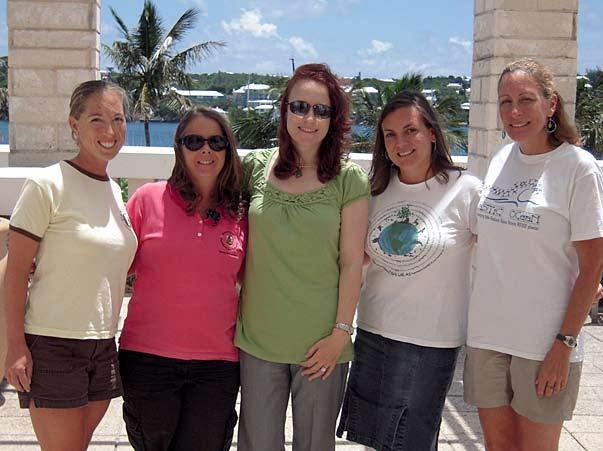 Cary Ralston
Cary Ralston
Oceanic gyres are circular ocean currents created by rotating high-pressure systems. Nine major oceanic gyres around the world have become accumulation zones for plastic debris, drawing hundreds of tons of plastic into their centers.
comes from landbased sources via intentional and unintentional littering. Unsecured truck beds carrying trash spew litter down our highways as they make their way to landfills, people toss plastic one-time use items out car windows, pedestrians litter if they can’t find a trash bin. Rain and
wind carry the items directly into water ways or down storm drains, where they then wash out to sea. Once there, currents and wind carry the tons of plastics into the gyres. There are five gyres in the world and all are thought to harbor large quantities of plastic. The North Pacific Gyre has been estimated to contain 10 million tons.
Why is it
a problem?
Harmful chemicals are in plastics, harmful plastics are in our oceans, chemicals leach from plastic when in water. The last place plastics should be is in the ocean. Chemical additives that make plastic pliable yet durable are found in drinking bottles–including baby bottles–as well as canned goods (many cans are lined with plastic). One such controversial chemical called Bisphenol A (BPA) is known to leach out of plastic: the warmer the beverage, the more it leaches. Once in the body, BPA is
(cont. on page 6)
Two Wilmingtonians–Bonnie Monteleone of The Plastic Ocean Project and Jennifer O’Keefe of Keep America Beautiful–voyaged into the North Atlantic Gyre to research pelagic plastics found on the ocean’s surface.
stored in organs rich in fat cells and has been shown to wreak havoc with the reproductive organs of rats because it mimics estrogen. In fact, BPA was originally developed in 1891 as an estrogen synthetic! Nearly every person tested has been found to have BPA in their bodies. Developing countries are starting to ban the use of BPA because of reports that it is an endocrine disrupter and is associated with cancers such as testicular, ovarian, and breast cancer. Yet we continue to produce over 6 billion pounds of BPA each year. These chemicals, among the hundreds of other plastic additives, have no known shelf life. Nor does plastic.
Plastics are ubiquitous in the water column due to their variability in buoyancy. Surface feeding fish as small as a few inches in length to marine mammals as large as Right whales often mistake plastics for food. Though the biological implications of plastic chemicals on
marine life are still in the research stages, the physical impact is not. The National Oceanographic Atmospheric Association (NOAA) estimates one million seabirds and over 300,000 marine life perish annually due to pelagic plastics. Ingested plastics, such as Styrofoam and Cellophane, obstruct the digestive systems of marine life. Plastic straps, bags, fishing line and parts of fishing nets collar their necks and eventually choke them or cut into their tissues causing infection. Many birds, fish, and marine mammals are entirely engulfed in nets made of durable plastics. They struggle to break free and many eventually drown from exhaustion. Nets the size of several football fields are lost at sea regularly and continue to be killing machines long after the fishermen have gone home.
I’m sure my mother wasn’t thinking the answer to her question, “Where does all this plastic go?” could be “in the ocean or worse, in the stomach of marine life.” And I wasn’t thinking that the very plastic in question would still be here on this planet somewhere 35 years later.
Monteleone is a Graduate Liberal Studies student, works in the Chemistry Office at
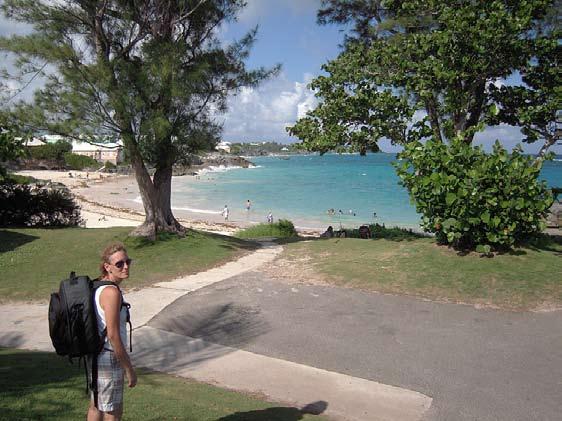
UNC–Wilmington and is the mother of Tricia and Francesco Monteleone. She discovered the environmental nightmare when she read the article “Plastic Ocean,” by Susan Casey, which documented research on the problem by Charles Moore, founder of the Algalita Marine Research Foundation (AMRF). The plastic ocean has become her mantra for educating people on the problems with plastics.
A major thrust of her studies, in collaboration with the AMRF, addresses the question, “If the gyre in the North Pacific is inundated with plastic, is the North Atlantic Gyre?”
Monteleone has just returned from an expedition aboard the Atlantic Explorer RV in July 2009, trawling for trash in the Atlantic along with Jennifer O’Keefe of Keep America Beautiful of New Hanover County. The two participated in a field study to explore the North Atlantic Gyre with the Bermuda Institute of Ocean Science (BIOS) and the University of California–Irvine. The team used a variation of AMRF and NOAA’s standard methodology for sampling the ocean surface as well as collected surface feeding fish to sample tissues for plastic contaminates.
Late in August Monteleone will also accompany the AMRF’s 10-year anniversary voyage into the North Pacific Gyre to aid in quantifying the rate of growth to the North Pacific garbage patch. Follow her progress online, or look for her follow-up story in our next issue. Learn more about the Algalita Marine Research Foundation at www.algalita.org.
North Carolina Bottle Ban Effective October 1
North Carolina’s new "bottle ban" goes into effect on October 1, 2009. New disposal bans will cover used oil filters, wooden pallets and plastic bottles, so throwing empties in the trash will no longer be allowed. The NC Division of Pollution Prevention and Environmental
www.p2pays.org.
Recycling plastic bottles conserves energy and resources, and creates jobs in the recycling industry. All New Hanover County Schools will have a 96-gallon roll cart for plastic recycling starting on October 1.
(Plastic in Our Oceans, continued)photo by Jennifer O’Keefe | Keep America Beautiful of New Hanover County Bonnie Monteleone heads to the beach to survey for plastics that have washed up on the shore of Bermuda.
Any water in the sea that is not close to the bottom is in the pelagic zone. The word “pelagic” comes from the Greek πέλαγος or pélagos, which means “open sea.”Assistance details how to comply with the new ban at
The Basics of Stormwater
by Jennifer ButlerWhat is stormwater runoff?

Did you know polluted stormwater runoff is the number one source of surface water pollution in the United States? Very simply, stormwater runoff is water from rain or irrigation that flows over land and directly into creeks, lakes, rivers and oceans. In Wilmington, stormwater runoff does not go to a treatment plant! Stormwater runs into our creeks, which ultimately flow into the Atlantic Ocean or Cape Fear River.
How does it work?
Impervious, or hard surfaces, such as driveways, streets, and rooftops prevent stormwater from naturally soaking into the ground. Instead, stormwater runs off these surfaces and picks up pollution such as pet waste, fertilizer, pesticides, auto fluids, yard debris, and litter before dumping them directly into our waterways.
As citizens, we desire clean, healthy waterways for activities such as fishing, swimming, recreation, and drinking water. By the same token, aquatic organisms and wildlife depend on clean water for survival. Stormwater runoff is the main culprit of pollution in our waterways.
What can you do?
Consider that anything on the ground can wash into storm drains and drainageways and end up in the nearest body of water—with no treatment at all. Would you want to swim, drink, or eat fish and oysters from this water? Would you want your children to play and splash around in it? Would you let your dog go swimming?
Now take a look around the yards, streets, and sidewalks in your neighborhood… do you see pet waste on the ground, grass clippings in the storm drain, fertilizer on the sidewalk, and your neighbor washing his car on the driveway? What you do everyday CAN make a difference for our waterways. Become “Stormwater Smart” and make clean and healthy waterways a reality for our area. The following tips will help you get started:
1. Never dump, sweep, rake, blow, or place anything into a storm drain, ditch, or waterway.
2. Always clean up after your pet and dispose of the waste in a closed trash can or pet waste digester, or bury it in a hole. Flushing pet waste down the toilet is prohibited according to Cape Fear Public Utility Authority ordinance. Don’t overlook outside cats; their waste is just as harmful.
3. Practice waterway-friendly lawn care!
• Get a free soil test from the New Hanover County Cooperative Extension (798-7680) to determine the exact nutrients your lawn needs.
• Grasscycle—leave grass clippings on the lawn to act as a natural fertilizer, compost yard waste, or contain yard debris for pick-up service.
• Install native plants to reduce fertilizer, pesticide, and water use.
• If you must use fertilizers and pesticides, use them sparingly and never before it rains.
• Collect fertilizer off driveways, streets, and sidewalks so it doesn’t wash away.
4. Keep yard waste out of storm drains and off of streets and sidewalks.
5. Prevent sediment and loose soil from washing away by adding mulch or plants to the exposed soil.
6. Put litter in the trash or recycling bin where it belongs. Reduce, reuse, recycle.
7. Wash your car on the grass or at a commercial car wash.
8. Check your vehicle for leaks and repair them immediately.
9. Dispose of hazardous household chemicals and used auto fluids at the county landfill or on Household Hazardous Waste Collection Days (798-4400).
10. Spread the Word! Tell a friend or neighbor how they can help protect our waterways too!

For more information, contact the City of Wilmington Stormwater Services, 910-343-4777 or visit www.wilmingtonnc. gov/publicservices/stormwater.
Jennifer Butler is the Stormwater Education Program Coordinator for City of Wilmington Stormwater Services. She is an avid surfer, which is one reason she is so passionate about clean water. She has spent the past year building a green home.
Next issue: Stormwater 101: What is a Watershed? courtesy of NCDENR
UNCW Osher Lifelong Learning Institute
Thursdays, Sept. 17–Dec. 17
13 sessions • 10 a.m.–noon $45/semester for Osher members; $65 non-members • Register by Sept. 16
SEA and Coffee Schedule
Science and Environment Academy (SEA and Coffee) meets weekly to present relevant environment/marine science information. UNCW professors and knowledgeable community presenters share their expertise and offer opportunities for enjoyable interaction in a friendly, relaxed setting. Call (910)962-3195 to register.
Sept. 17 Gardening Behind Bars with Nicolle Nicolle, Horticultural Therapist, Pender Correctional Institution
Sept. 24 Green/Sustainable Building in NC & Beyond with Scott Ogden, AIA/ Partner, B + O Design Studio, Pllc.
Oct. 1 Beat the High Cost of Gas with Electric Cars with Bouton Baldridge, Member of Wilm/Coastal Carolina EAA
Oct. 8 The Biology and Behavior of North Carolina Butterflies with Matthew Collogan, Environmental Education Program Manager, Airlie Gardens
Oct. 15 The Popular Image of Pirates with Dr. William McCarthy, Associate Professor of History, UNCW
Oct. 22 Dr. Strangelove Revisited: Or How I Learned to Stop Hating Hog Waste and Appreciate Its Inner Beauty with Dr. Lawrence Cahoon, Dept of Biology and Marine Biology, UNCW
Oct. 29 Building Green Homes in Wilmington with Frank A. Cardamone, IV, Green Built Homes, L.L.C.
Nov. 5 What Has Happened to the Bees with Barry E. Harris, Jr., Beekeeper, Brunswick County Beekeepers Assoc.
Nov. 12 The Arboretum-Wilmington’s Best Kept Secret with Ed DeMarco, NHC Cooperative Extension
Nov. 19 Art and The Environment with Abby Spangel Perry, Independent Art Company and art instructor at CFCC
Dec. 3 The Life and Times of Birds: A North Carolina Perspective, Andy Wood, Education Director, Audubon North Carolina
Dec. 10 Exciting Advances in Solar Energy with Richard Campagna, Regional Manager Advanced Green Technologies
Dec. 17 Nuclear Energy in the 21st Century with Dr. Liping Gan, Assoc Prof, Physics Dept., UNCW
sustainable picnics News from our Sister Green City, Eugene, Oregon
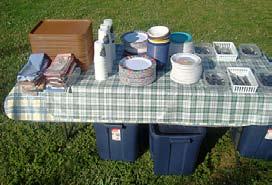 by Alysoun House
by Alysoun House
Peterson (clarinet) decided to try and make the event as waste-free as possible. Friehl checked out several sets of durable picnicware (plates, glasses and flatware) from the Lane County Master Recycler Program. She and Peterson researched and provided suitable recycling bins. And, come party time, they were ready with clearly labeled containers and a helping hand when needed.
Friehl was initially told the only nonrecyclable party product would be meat. After checking with Master Recycler Anne Donohue, she learned that even the meat
When the New Horizons Band of Eugene planned their end-of-season picnic, they wanted to make a change. At their season’s end in June, the 30-member community band traditionally holds a free concert in the park and hosts a cookout for friends and family afterward. The band provides hamburgers, veggie burgers and the fixings, while band members bring side dishes and drinks.
“It’s amazing how much trash a party of that size can generate.” says Band President Alysoun House. So this year Janette Friehl (euphonium) and Susan
Tips for a Waste-free (or Waste-less) Cookout or Party
– Ask guests to bring their own reusable place settings and cloth napkins. Everyone has a few mismatched forks and knives they wouldn’t mind bringing to a party. Bandanas make an inexpensive and fun picnic napkin.
– Provide clearly labeled bins for recyclables, deposit bottles, and compost. Five–gallon buckets make great compost-haulers, plastic dishpans facilitate cleanup.
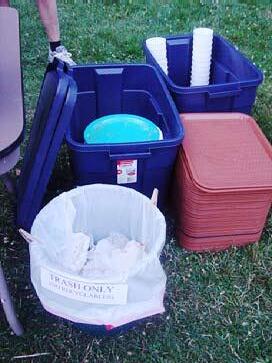
– Make a spatula available for folks to scrape their own dishes.
– It helps to have someone nearby during peak clean-up time to make sure the process goes smoothly.
– For larger gatherings, work the waste-free concept into the planning process.
– If this seems unfamiliar, ask for help. A friend may have a compost bin they are willing to share; another can help sort recyclables on site.
– Share grill time. A single propane grill can take care of all but the largest parties and avoids the toxins released from burning charcoal.
Want to start your own reusable place-setting system? In addition to the County Extension, several Eugene churches have developed their own kits. What better way to be stewards of the Earth?
sustainable picnics
Another band member who had planned to bring bottled juice opted instead to pre-mix the juice and serve it from reusable pitchers.
When the band members signed up for their side dishes, they were reminded to bring reusable rather than disposable trays, dishes and utensils. Many band members opted to bring their own place settings, plates and napkins, a practice increasingly common in Eugene. “It will be interesting to see how little waste is generated from the projected 100 people attending this event” says House.
scraps could be composted. The tuba player volunteered to dig the 10"-14" deep hole, bury the meat scraps, and place a heavy object on top to discourage digging by animals.
At band party planning meetings the members discussed other ways to reduce waste. One member volunteered to bring bottles of water. Friehl asked if they could obtain large, reusable containers rather than individual bottles. “Recycling is really the last step, and it takes lots of energy to recycle the plastic. Reusing cups, as opposed to recycling bottles, carries much less impact to the environment.” As a result, the band procured two large containers to provide water for the concert.
Was it successful? See the photo below. The tally was closer to 130 people, and Friehl reports, “The actual waste totaled only a half a pound. We recovered 6 ¼ pounds of compost, ½ pound of meat scraps—I fed these to my dog—and four
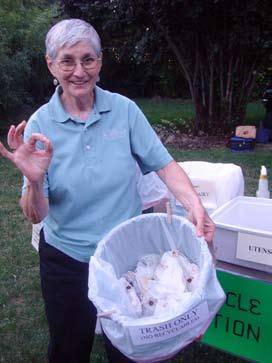
pounds of recyclable items. It was successful beyond my wildest imagination.”
Alysoun House is Deputy Sheriff of Lane County, Oregon. She plays tuba in the New Horizons Band of Eugene. Contributing Editor Mary Robertson also contributed to this article.
Make Your Own Picnic Kits
Interested in forming your own “reusable place setting” bins? We asked the coordinator of the Master recycler program, Kelly L. Bell, how it got started:
“In terms of an event waste reduction strategy, recycling and eliminating oneuse items is the single biggest impact you can make. Compostables are practical for very large events but completely unnecessary for smaller venues like weddings and picnics.”
“These kits were collected by Master Recycler Ron Peterson and his partner Johanna Mitchell over the course of a year. They found dishes, utensils and napkins from thrift stores, garage sales and restaurant supply stores.”
Bell says the Lane County Waste Management Division purchased the kits from Ron and Johanna and began loaning them out in May of 2008 as part of their Event Waste Reduction services. They see the kits as a teaching tool and a demonstration project—in hopes the idea will catch on. “Either groups will build their own kits or someone will see the need for a rental business—it currently does not exist except for fine china and glassware.”
returning the kits complete, or replacing any missing pieces.
Bell reports in the first year (MayDecember 2008) the dishes were loaned out to 15 events with a total estimated attendance of 1340. So far this year (January-August 2009) the dishes have been loaned out for 24 events with a total estimated attendance of 2845. “I have to turn folks down on a regular basis that want to borrow dishes because they are already reserved, ” says Bell.
The City of Eugene Neighborhoods Program started making durable dishware, recycle bins and other event equipment available in 2009 for Neighborhood Association events.
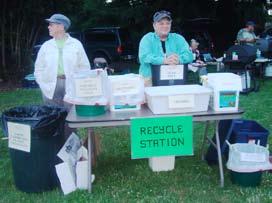
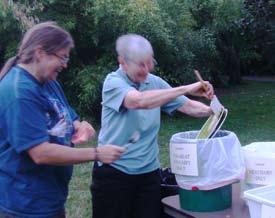
Friehl shows just how successful it turned out: Here’s the lone trash can at the end of the party.
The kits are available on a first-come-firstserved basis, and are free of charge. The users are responsible for washing and
Local congregations have also started assembling their own systems: they see caring for the earth as a logical extension of their spiritual practice. Phyllis Weare, who assembled a kit for 40 for First Christian Church in Eugene, says it didn’t take long for her to gather the needed materials. “When I see something at Goodwill, I just pick it up.” For napkins she chose ten-packs of cotton washcloths in bright colorseasy to wash and dry on the line with no ironing. “I think it was partly because I was raised during the Depression, where we didn’t throw anything away,” laughs Weare. “But the world is calling for it now.”
ocean exploration
Deep Sea Coral Reefs
The deep sea, once thought to be a cold, dark, and relatively lifeless zone, is yielding surprising new information. As human activity continues to alter the makeup of the air and sea, scientists are racing to unravel the mysteries of deep sea coral reefs in order to protect these magnificent ecosystems and to better understand their benefits to the environment.
Steve Ross, research associate professor at the University of North Carolina–Wilmington’s Center for Marine Science, will serve as chief scientist for four major cruises, beginning in August and ranging from North Carolina through the Gulf of Mexico. He will be joined by an international and multiagency team of scientists using a variety of technologies to study deep sea reefs—those located deeper than 1000 feet—which until now have been largely unexplored and misunderstood.
“This year we are mounting an unprecedented effort to gain valuable data about one of the most amazing marine habitats in United States waters, a habitat that contains rich rewards for these efforts” said Ross.
The first cruise, in early August, traveled to the Lophelia coral reefs off the coast of Cape Canaveral, Florida. Ross, joined by John Reed, senior research scientist with Florida Atlantic University, and a team of researchers from around the
world, collected and studied samples from deep sea coral reefs using a variety of technologies ranging from a submersible pod that allows the scientists a first-hand view, to remote infrared cameras that chronicle underwater life without scaring it off. What the scientists found surprised even them.
“Deep sea coral reefs are oases in the deep ocean, a province that was thought to be less diverse than shallower waters,” said Ross. “The deep water reefs provide huge biodiversity, which is required for a healthy ocean.”
The Lophelia reef area is part of more than 23,000 square miles of coral and hardbottom reefs of the U.S. coast—the largest known expanse of deep-water reefs in the world.
The South Atlantic Fishery Council (SAFMC) has proposed that this area be considered a deep sea coral Habitat Area of Particular Concern (HAPC). Such a designation would protect the area from bottom trawling and other human-made damage. Scientists will combine information collected during this cruise with data from previous research to help make the case for protecting the reef area. A final decision on the designation as a HAPC is expected in late 2009: SAFMC will vote on the designation which, if passed, will go to the National Oceanic and Atmosphere Administration (NOAA) for final approval.
Research partners on the first expedition included UNC–Wilmington’s Center for Marine Science, Florida Atlantic University’s Harbor Branch Oceanographic Institute, United States Geological Survey (USGS), Scottish Association for Marine Science, National Oceanic and Atmospheric Administration Fisheries Service, Marine Conservation Biology Institute
and the North Carolina Museum of Natural Sciences.
Due to their depth, only in the last 10 years has seafloor mapping technology allowed researchers to find and properly study these ecosystems, making their full impact on the environment and marine life a mystery scientists now have a chance to solve. The cold, deep water where deep sea coral reefs live has so far sheltered them from the temperature increase and pollutants that have affected reefs in shallow waters; however, that may change in the future. Deep water reefs are particularly vulnerable to bottom trawling, a fishing technique that scrapes the sea floor, crushing coral along the way and sending up plumes of sediment and debris visible from space.
Even subtle shifts in seawater’s temperature and chemistry can affect the reefs. The changing makeup of the earth’s atmosphere causes seawater to absorb more carbon dioxide, rendering it more acidic. This reduces the amount of calcium carbonate available for ocean life to create the skeletons that make up a coral reef.
“Once you incorporate a one-degree temperature change in the deep ocean, it may stay there for decades before that

continued on page 11
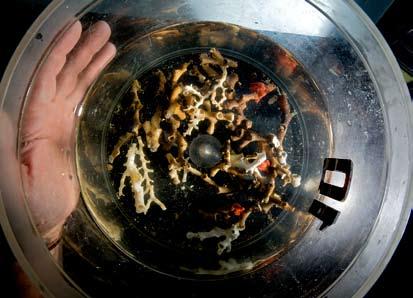
To read further:
• Follow Dr. Steve Ross and his team as they continue to explore deep ocean habitats: www.uncw.edu/nurc
• Join the “Revealing the Deep” group on Facebook: www.facebook.com
• Read daily expedition logs or request curriculum materials from the Life on the Edge Educator: http://naturalsciences.org/microsites/education/deepsea/index.html

• See the effects of bottom trawling here: www.livescience.com/environment/080220-trawling-effects.html
The Science Team, on deck in front of the Harbour Branch Johnson-Sea-Link manned submersible they will use to explore the deep sea study area. The sub holds up to four people; a typical dive lasts approximately four hours. Front Row (from left): Cheryl Morrison, Steve Ross, Julie Galkiewicz, Amanda Demopoulos, Cheryl Ames. Second row: Leslie Wickes, Stacey Harter, Sandra Brooke, Murray Roberts, Jenny McClain, Martha Nizinski, Liz Baird, Art Howard. Third row: Tara Casazza, Mike Rhode, John Reed.
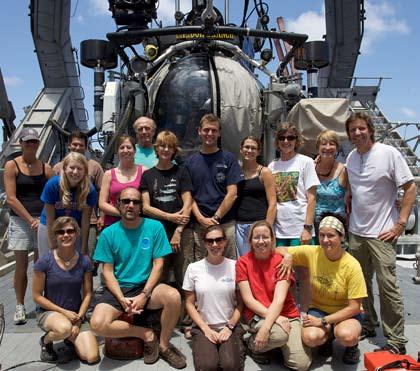
Analysis of data is a collaborative effort, involving a variety of tasks. In the ship’s lab scientists process samples, including identifying material, entering data, and planning where the next stations will be. Once the team returns home, it may take over a year to analyze the data obtained from an expedition lasting 12 days.
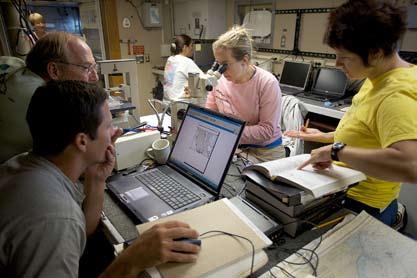
heat can be released,“ said Ross. “Corals are old and slow growing, so they may never recover from the damage.”
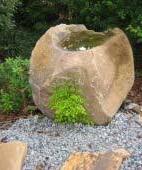
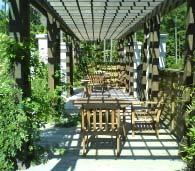

Some corals have rings similar to trees that allow scientists to measure environmental changes over time. These coral forests may give scientists a several-thousand-year record of environmental changes such as ocean temperatures, ocean productivity, volcanic activity and dust storms. The scientists will also study habitat distribution and the population construction of marine life. Team members on previous trips to the deep discovered several new species of fish, starfish and eels. Studying new species, even those from the deep, can yield valuable insight into life on the planet, including innovative medical treatment for humans.
This research is funded by NOAA’s Deep Sea Coral Science and Technology Program, United States Geological Survey, University of North Carolina–Wilmington, Florida Atlantic University and the North Carolina Museum of Natural Sciences.

photos this article ©2009 www.arthowardphotography.com
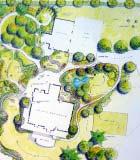
This egg-bearing female crab measures only one inch across: the photo to the right is closer to actual size. Its genus is Paralomis, but because the species is not yet known, it is described as Paralomis sp.
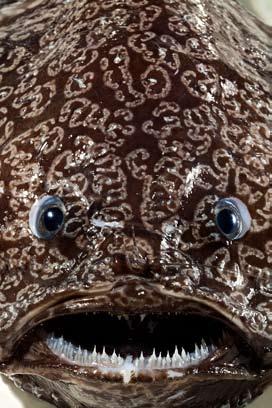
“Sunday afternoon’s dive brought an unexpected find, a deep water goosefish called Sladenia shaefersi. This goosefish is such an infrequent catch that it does not even have a common name. It has a wide mouth filled with sharp teeth, eyes that point more upward than forward and dark smooth skin covered with spiral-shaped white markings.
“This is the first specimen caught in United States waters and only the third caught in the world. It
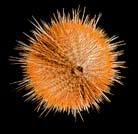
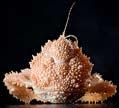
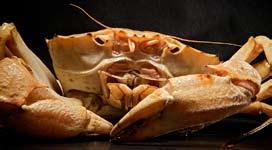
was exciting to collect this fish and be able to examine it closely.
“Finding this fish here and coupling it with the photographic evidence from the Gulf and South Carolina, suggests that it might not be as rare as we think. It may simply be that, because this habitat is so difficult to sample, these fish have remained hidden. These deep water reefs provide extraordinary habitat for a variety of species. The reefs themselves are hard to reach and even more difficult from which to collect.
The Johnson-Sea-Link submersible is one of very few ways we can explore the area and sample for specific animals. This goosefish might also be tied very strongly to this reef habitat, just as Polar Bears are tied to the Arctic.”
[Blog text courtesy of Liz Baird, Director of School Programs, North Carolina Museum of Natural Sciences. Search for “Life on the Edge” at http://naturalsciences.org.]
“One of the things that made a big impression on me was the value of using submersibles to study the deep. Nets and trawls don’t give a complete picture of what is out there, and the limited range of view provided by AUVs and ROVs hampers your ability to observe the surroundings. There is a threat to the funding for submersibles, and I worry about how it might impact our work. During my bow dive I was watching a collection of coral, and out of the corner of my eye saw something move. When I looked more closely, a highly camouflaged Goosefish seemed to appear magically from the bottom. Its color and pattern matched the substrate so completely, that if it had not moved we would have never seen it. There is something inherently valuable in being immersed in the environment you study, be it a rainforest, a pine savannah or the deep sea.”
—Liz BairdBrachyuran crabs have wide bodies and two powerful claws. This Chaceon fenneri, or Golden Crab, is a commercially important species that uses the deep coral habitat.
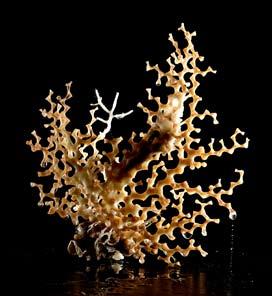
Although genetically related to the brachyuran crab pictured above, the galatheid crab looks quite different: its shell (carapace) is much narrower and it has slender claws. This species is Eumunida picta, which is often called by its common name, Squat Lobster.


“The deep water reefs are irreplaceable. Once destroyed, it may be impossible for them to re-establish themselves.”
—Steve RossThis species of sea urchin (Echinus tylodes) is common on deep-sea corals of this region.
Research team members share their experiences of their August expedition . . .
It is not always obvious even to the experts what kind of animal they have found. It will take some research to determine the genus and species of this starfish, collected during the expedition.
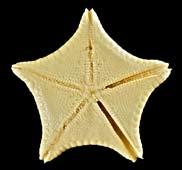
traveled
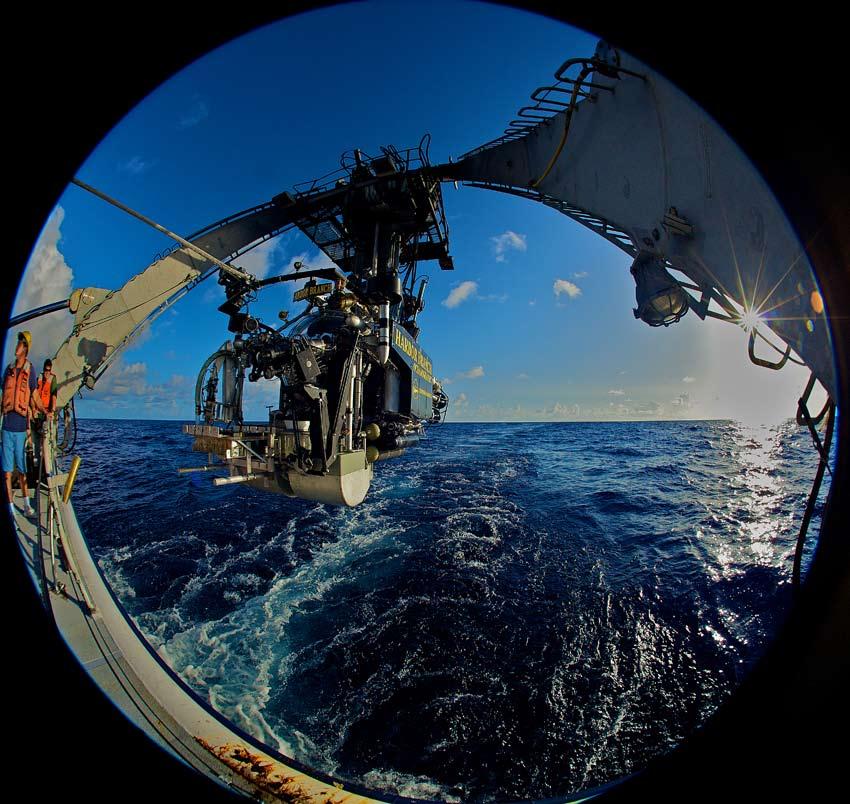
In August 2009, a team of scientists
to the Lophelia coral reefs to learn about this fragile ecosystem.
green jobs
Green Jobs Act: Closer to Reality
Randall G. Flood, Executive Director of the Green Jobs Alliance, a non-profit national organization dedicated to establishing the infrastructure needed to help the nation become more sustainable, is excited and encouraged by President Obama’s commitment to making the “Green Jobs Act” a reality. His comments follow.
Thanks to President Obama and his Administration, the Green Jobs Act may be on the verge of becoming a reality for millions of Americans. The Act was actually passed and enacted into law as Title X of the Energy Independence and Security Act of 2007.
Although it authorized $125 million in funding for education and green jobs training, it was never funded by the Bush Administration or the Congress. Nor was any attempt made by the Department of Labor at the time to establish the infrastructure that would serve to implement the Act.
All that is now destined for change. Former Congresswoman Hilda Solis (D-CA), the principal author of the Green Jobs Act, now serves as President Obama’s Secretary of Labor. Green Jobs advocates such as Green for All, the Apollo Alliance, the Blue Green Alliance, and of course, our own Green Jobs Alliance, are all hopeful that we be able to give meaning and substance to the Act.
If properly implemented, the Green Jobs Act will have an incredible, positive impact on our Nation’s economy, creating thousands of jobs throughout the country in areas that will not only help Americans become more energy efficient, but will help conserve our natural resources and safeguard our environment for the future.
The effects of this act are far-ranging: it is designed to create jobs while helping the country move toward a sustainable future. It proposes to help Americans retrofit commercial buildings to be more efficient,
expand mass transit systems, improve the Smart Grid (a nickname for an ever-widening palette of utility applications that enhance and automate the monitoring and control of electrical distribution), promote wind and solar power, and create more advanced and efficient biofuels.
The jobs needed to make these happen are even more diverse: from engineers to truck drivers, from machinists to agricultural workers. Anyone who is responsible
The Green Jobs Alliance: Who We Are, What We Do
by Randolph G. Flood, Executive Director, Green Jobs AllianceInspired by the writings of authors Thomas Friedman (Hot, Flat & Crowded) and Van Jones (Green Collar Economy), the founders of the Green Jobs Alliance created a nonprofit partnership in direct response to the Green Jobs Act; to help establish the infrastructure that would implement the Act, help our economy, reduce our dependence on foreign oil, conserve our natural resources and protect our environment.
A national, nonprofit organization, the Alliance has formed a coalition of Labor organizations, renewable energy industries, educational institutions and technical “Pathways Out of Poverty” training academies, green construction companies, environmental groups, veteran’s groups, community-based organizations, and sustainable energy-related small businesses, to help implement the Green Jobs Act.
With a focus on specifically training individuals in areas of energy efficiency and renewable energy, GJA is reaching out to military veterans, working to attract a green manufacturing base to the Southeastern and Mid-Atlantic regions, championing offshore wind turbines as a viable renewable energy alternative, and exploring possible vessel or platform construction to install and maintain offshore turbines—while collecting scientific data from the ocean.
for designing creating, building and maintaining a more efficient infrastructure is needed.
For instance, simply promoting wind power throughout the country –whether generated by turbines or offshore—can create thousands of green jobs: as a sample, the act lists “Environmental Engineers, Iron and Steel Workers, Millwrights, Sheet Metal Workers, Machinists, Electrical Equipment Assemblers, Construction
Other activities of the Alliance include:
• Developing a plan to provide outreach to high schools and local communities on green career opportunities;
• Hosting green careers educational seminars, workshops, and conferences;
• Supporting a “one-stop” Green Careers Center that identifies green job opportunities and green job candidates throughout the Nation;
• Assisting with job placement, data collection, and gathering labor statistics; and
• Sponsoring a public affairs forum for educating the general public about energy and environmental issues.
The Alliance is currently pursuing federal Stimulus funding for its training partners to help provide education to American workers in green jobs, while establishing a long-term, self-sustaining state chapter network that will be self-sufficient in the years ahead. In Virginia, the Alliance has been designated as a “State Energy Sector Training Partner” (as required by the Green Jobs Act in order to be eligible to receive federal grant monies via the state) in the Commonwealth of Virginia, and is working to establish chapters in Virginia, North Carolina, Maryland, Delaware, and Alabama.
A complete team player, the Green Jobs Alliance is very supportive of other organizations such as Green for All, and the Apollo and the Blue-Green Alliances, in advocating green jobs and implementing of the Green Jobs Act.
For further information, contact us at 757-788-9073 or visit our website located at www.greenjobsalliance.org.

green jobs
continued from page 14
Equipment Operators, Industrial Truck Drivers, Industrial Production Managers, First-Line Production Supervisors,…” 1 as well as wind turbine designers, welders, and others associated with turbine construction.
Along the coastlines of America, Ocean Technology or Tidal Wave Power is also being explored to potentially generate jobs—occupations similar to those listed in the Wind Power category.
What type of individuals will be trained? The Act establishes an “Energy Efficiency and Renewable Energy Worker Training Program” that targets eligible individuals to be given priority for “green” jobs training. These include:
• Unemployed citizens;
• Military veterans;
• At-risk youth including teens who are “aging out” from the state foster care systems;
• Workers affected by national energy and environmental policy;
• Individuals in need of updated training related to energy efficiency, renewable energy industries, and green careers;
• Formerly incarcerated, adjudicated, non-violent offenders;
• Underemployed individuals.
In an effort to assist low-income workers, a “Pathways Out of Poverty” section encourages occupational training; safety and health training; basic skills, literacy, GED, ESL, and job readiness training; and training leading to community college or industry-recognized certificate training; internships; career leader training; transitional jobs strategies; and supportive services.
NOTES:
To provide these green jobs skills, the Act proposes that industry, labor unions, community-based groups, schools, local government agencies, and Veteran’s Administrations form non-profit partnerships—they will then be eligible for federal grant money to implement the education and training programs associated with the Act. 2
The Green Jobs Act is good legislation; it simply needs funding and the appropriate infrastructure to do its work. The House-passed version of the Climate Bill (other wise known as the American Clean Energy & Security Act) increases the authorization amount in the original Act from $125 million to $150 million, and is now awaiting action by the Senate. It would not be surprising if the Senate increases the authorization even further, as it agrees with the House that green jobs are vital to reviving our nation’s economy.
In addition, the American Recovery and Reinvestment Act (ARRA) of 2009 provides $500 million in competitive grant funding for “…research, labor exchange and job training projects that prepare workers for careers in energy efficiency and renewable energy…” 3
Although this money is only two-year “Stimulus” funding and does not permanently fund the Green Jobs Act, it is green jobs training money that is intended to retool America’s workers, including those impacted by national energy and environmental policy and in need of updated training related to energy efficiency and renewable energy industries.
1 Pollin, Robert, and others. Center for American Progress, Green Economic Recovery Program: Impact on States. Amherst, Mass: Political Economy Research Institute (PERI), University of Massachusetts, 2008. www.americanprogress.org and www.peri.umass.edu
2 Title X, Energy Independence and Security Act of 2007, Page 1750.
3 American Recovery and Reinvestment Act of 2009, Page 59.
4 Jones, Van. The Green Collar Economy: How One Solution Can Fix Our Two Biggest Problems. New York: Harper Collins Publishers, 2008.
The Green Jobs Alliance is encouraging all of our partners and potential partners to apply for these monies through a series of Department of Labor solicitations (5) that have been issued this past June. The grants, which range from $2 million to $8 million, will help localities (through properly organized strategic partnerships) acquire much needed education and training monies for green jobs. The DOL Web site link can be found at:
www.doleta.gov/grants/find_grants.cfm
So many of the technologies covered by the Act are particularly relevant to the Coastal Carolina area: especially wind, solar, and wave power. For those in North Carolina, particularly in the Cape Fear to Elizabeth City coastal region, the Alliance would be pleased to assist organizations and localities in pursuing these federal grants as we work to organize a state chapter in North Carolina.
Given the realities facing our Nation, from unemployment to climate change, never in recent times have we as Americans been confronted with more difficult challenges or a greater opportunity to change America for the better. To quote Van Jones—Founder of Green for All, and now White House Advisor to the President—from his bestselling book, Green Collar Economy, “…Imagine a New Deal, with a pivotal role for green entrepreneurs, a strategic and limited role for government. And an honored place for the social activist. Such a force would change the direction of our society. It would put government on the side of the problem solvers in the U.S. economy, not the problem makers—and bring us all together…” 4
It’s not too late for you to join the “Green Revolution.” In fact, it’s just beginning.
This article updates one that previously appeared in the May/June 2009 issue of the Green Careers Journal: www.environmentalcareer.com/gcj.htm.
If properly implemented, the Green Jobs Act will have an incredible, positive impact on our Nation’s economy
Oyster Reef Rebuilding Brings Coastal Jobs
Buxton resident Darren Burrus has had less work for his company over the last year, but now things are looking up. Thanks to a Recovery Act grant from the National Oceanic and Atmospheric Administration (NOAA), his small business, Cape Dredging Inc., will be building oyster reefs off Hatteras Village.
“We’re excited to get back to work. The marine construction business has been slow,” said Burrus, a co-owner of the company. “And having more oysters and fish around will be good for the watermen and oystermen. I love North Carolina oysters.”
Through NOAA Recovery Act funds, the North Carolina Coastal Federation, working closely with the N.C. Division of Marine Fisheries, scientists and other
private industry partners, received a grant of $5 million in June for a project to put private industry to work rebuilding the state’s oyster reefs. The project will save or create 140 jobs, many of them in industries hard-hit by the economic downturn, such as commercial fishermen, quarry workers, tug boat and barge operators and fisheries technicians.
The money will be used to build two large oyster sanctuaries in the Pamlico Sound, one off Hatteras at Clam Shoal and one off Stumpy Point at Crab Hole. The oyster reefs, which will be created with 54,000 tons of stone, will cover over 46 acres. As designated oyster sanctuaries, the reefs will not be available for harvest. They have valuable benefits to both commercial and recreational fishermen, however, as nurseries for oysters and valuable species of fish. Computer modeling studies have shown that these oyster reefs produce larvae that travel to other parts of Pamlico Sound.
“The project provides immediate job benefits and enhances ongoing efforts to improve oyster and fish populations, as well as improve water quality,” said Division of Marine Fisheries Director Louis Daniel.
“The two-year project will move state efforts to build and enhance oyster reefs ahead about 6 years,” said Craig Hardy, chief of the division’s Resource Enhancement Section.
“We’ve all worked hard to bring oysters back to the North Carolina coast,” said Todd Miller, the federation’s executive director, referring to several years of ongo -
ing efforts. “This project allows us to keep the momentum going and even accelerate it in these rough economic times. The fact that we can employ some barge and tug crews to do it just makes it better.”
Another component of the project pays fishermen to plant 40,000 bushels of oyster shells in 19 locations from Ocracoke to Myrtle Grove Sound and Topsail Sound. This program, which the Division of Marine Fisheries will begin in the spring, will provide supplemental income for many fishermen hit hard by the economic downturn.
The project will be monitored by a team of scientists from N.C. State University, UNC–Wilmington and North Carolina Sea Grant.
NOAA’s Community-based restoration program is charged with coastal habitat protection and creation. The American Reinvestment and Recovery Act added job creation and protection to their charge. The NOAA Community-based Restoration Recovery Act grant program gave out $167 million dollars for 50 projects.
NCCF: “Citizens Working Together for a Healthy Coast”


The North Carolina Coastal Federation (NCCF) is the state’s largest nonprofit organization working to restore and protect the coast. NCCF headquarters are located at 3609 Highway 24 in Ocean between Morehead City and Swansboro and are open Monday through Friday from 8:30 am to 5 pm.

The headquarters include NCCF’s main offices, the Cape Lookout Coastkeeper office, a gift shop, Nature Library, Weber Seashell Exhibit, ShoreKeeper Learning Center, and adjoining nature trail.

The NCCF also operates field offices in Wilmington and Manteo. For more information call 252-393-8185 or check out NCCF’s website at www.nccoast.org

local green building news
Canstruction® 2009 Comes to Wilmington
Come witness green building of a different sort...The American Institute of Architects (AIA), Wilmington Section is sponsoring Canstruction® 2009, a competition in which teams of architects, engineers and students design and build giant structures made entirely from full cans of food. Eight teams have registered for the local event, which is part of a 20year-old program held in cities throughout the world. Canstruction® is a registered trademark of the Society for Design Administration.
Participating teams are soliciting donations of cash in advance to purchase cans of food for their entry. Structures can reach a size of 10' x 10' x 8' high and require thousands of cans. Advance donations allow the teams to purchase
quantities of cans the size and color that will contribute to their design. At the close of the exhibition, all cans will be donated to the local food bank, the Food Bank of Central & Eastern North Carolina (www. foodbankcenc.org).Participating teams as we go to press are:
Team 1 Society of American Military Engineers
Team 2 proVision Architecture
Team 3 Woods Engineering
Team 4 WK Dickson
Team 5 LS3P Associates LTD
Team 6 B + O Design Studio (+ ILM Design Build + Big Sky Design)
Team 7 Commercial Interior Resources
Team 8 Monteith Construction
Canstruction entries will be displayed at Independence Mall the last weekend in August through Labor Day weekend. The public is invited to come watch the construction in process: the “build out” will be held the morning of Saturday, August 29 from 10 a.m. until about 3 p.m. The completed can sculptures will be on display in the Mall through Labor Day (September 7).
For more information and to see examples of past creativity, visit www.canstruction.org. Contact your team of choice to donate in advance, or call (910)547-4390.
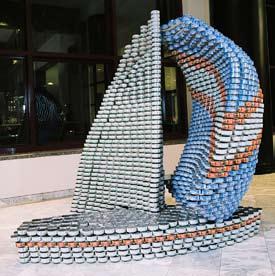
There will be a donation box at Independence Mall where the general public can donate non-perishable items that will be collected by the food bank. Independence Mall is located at 3500 Oleander Drive, and opens at 10a.m. on Saturdays.
Get the inside scoop on homes, businesses and schools featuring green building products and technologies on this self-guided tour. Site owners, green builders, designers, contractors, installers and other experts will be on hand at tour sites to answer your questions.
More information coming soon! Event details will be posted at www.cfgba.org as plans are finalized.
Green Living Expo and Conference October 21
Greater Wilmington Business Journal and Wilma Magazine will collaborate with Cape Fear Green Building Alliance to produce a green conference and expo on October 21, 2009. The Green Living Expo and Conference will take the place of the CFGBA expo traditionally held during Riverfest weekend.
The expo and conference will comprise three components:
1) Educational classes throughout the day for green building professionals, other green businesses and the general public. CFGBA is responsible for organizing and presenting the entire green building educational curriculum at the event.
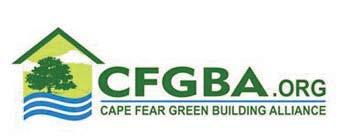
2) A luncheon featuring a high-profile business leader providing insight into her or his own firm’s green initiatives.
3) A large-scale vendor expo to showcase products and services to the community.
For information about special sponsorship packages and exhibit booths for the expo, contact Judy Budd at either (910)343-8600, extension 212, or jbudd@ wilmingtonbiz.com.
Solar and Green Tour Call for Nominations
Cape Fear Green Building Alliance (CFGBA) seeks nominations for building projects to feature on the annual Solar and Green Building Tour scheduled for Saturday, October 10, 2009. Residential, commercial, industrial and institutional buildings are eligible for consideration. The selection committee will strive to showcase a variety of green strategies and renewable energy solutions. To nominate a project for inclusion in the tour, contact Nick Lauretta at nick.l@cfgba.org.
Please support our advertisers. And please mention you saw them in Cape Fear’s Going Green!
Local Business Owner Certified as Green Consultant
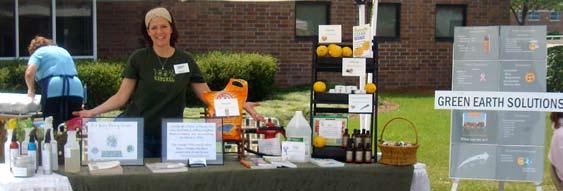
Nancy Keith of NC Green Consultants, LLC was certified as a Green Consultant by the Green Business League in April. The Green Business League is a national organization certifying consultants and businesses that use green practices to promote sustainability, reduce their impact on the environment and improve business performance. NC Green Consultants, LLC pursues a mission to raise awareness and encourage actions of environmental stewardship and social responsibility. More information is available at www.ncgreenconsultants.com.
Carolina Blue is Going Green
Carolina Closet Company is now offering custom-designed laminate closet systems that are eco-friendly. You can choose from a formaldehyde-free laminate or wood closet systems made from bamboo. Contact them at (910)686-3277.
Green Giggles
When Brandy Metzger became a mother she had difficulty finding locally the products she wanted for her baby. In February she started a company, Green Giggles, to educate people about and sell quality ecofriendly and natural baby care products. .
Green Giggles conducts free educational seminars monthly at Tidal Creek Community Center and offers direct sales through seminars, home shows and “green” baby showers. The Web store at www.greengiggles.com was launched in
Life in Trolldom
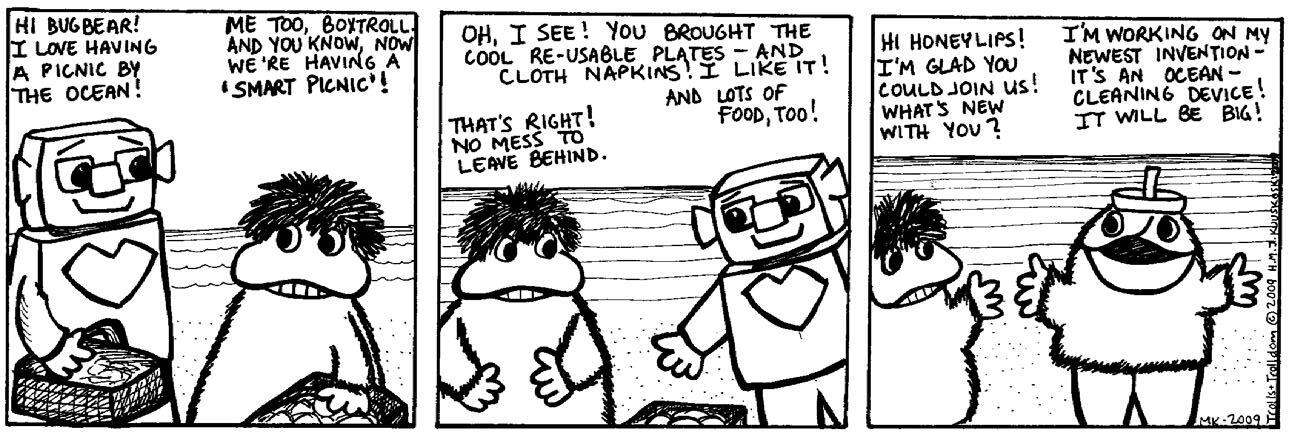
Teri Mageau, owner of Green Earth Solutions, displays her popular green cleaning solutions at the Coastal Living Show. Mageau creates and concocts all her own cleaning materials, using only natural items; her all natural, Earth friendly cleaning service is an outgrowth of the demand for her products. Contact Green Earth Solutions—(formerly TJ’s Clean Sweep)—to learn how use of all natural products can improve your home and office environments. Email GreenEarthSolutions@hotmail.com, or call Mageau at (910)620-1668.
June. However, Metzger encourages local parents and caregivers to contact her about products and order directly through her, to save on shipping costs, and to receive that human connection you just can’t get on the internet! Metzger can be reached at greengigglesinfo@gmail.com or by phoning (910)262-6810.
Green Baby Diaper Service
Polly Buskirk, Josh Bobbit and Liz Soffera have started the only diaper service in town—and it’s green! Cloth diapers offer a healthy, environmentally friendly alternative to disposables. This is a family-owned and operated business. Learn more about the benefits of cloth diapers—and the treat of having someone keeping you supplied with fresh ones— at www.greenbabybiz.com. Call them at (910)399-3051,
or visit their store at 6006 Oleander Drive, across the street from Progressive Gardens.
Luna Pops
Luna Pops are frozen popsicle treats designed for those drawn to all natural ingredients. Handmade locally of fresh fruit and other seasonal ingredients—no high fructose corn syrup here—the pops are based on the idea of paletas, a treat from Central America. Because of its proximity to the beach, Wilmington seemed the perfect spot for the enterprise. Find them at Landfall Center, or at their newer locations at Topsail Island or Oak Island. Their 20 ever-changing flavors are also available at the Luna Pops cart, at Riverfront Market, on Saturday mornings while the weather is still warm. Learn more at either www. lunapops.com or (910)538-5452.
Send your

local products and inventions
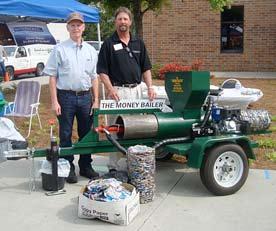

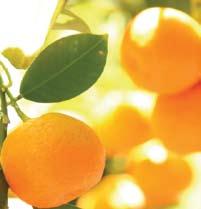
The Money Bailer
Joe Parnell likes to solve problems, and one he addressed recently was this: recycling aluminum cans is not efficient if you don’t have a way to compress them.
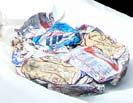
Enter The Money Bailer. You pour cans in the hopper, and the machine compresses them into a flat disc. Pour
more, and each

next to the first.
disc,
and containing about 500 cans. Buy the machine, or your church or school group can rent one by the month for a special fund-raising event. Recycling companies like the individual discs; the pancake shape allows quality control to ensure no foreign objects are included. Visit www. moneybailer.com or call (910)799-2494 to see whether there’s a bailer in your future.
Be Ready When It Rains
Save money, conserve water, and promote a healthy environment...by collecting natural rainwater year-round to water your plants, lawn, and garden, and wash your car, too!

To encourage conservation, Brunswick Soil & Water Conservation District is promoting the use of rain barrels, offering the 65-gallon barrels at a reduced price of $95, or 35% below retail. For more pictures and more information, see www.rainwatersolutions.com.
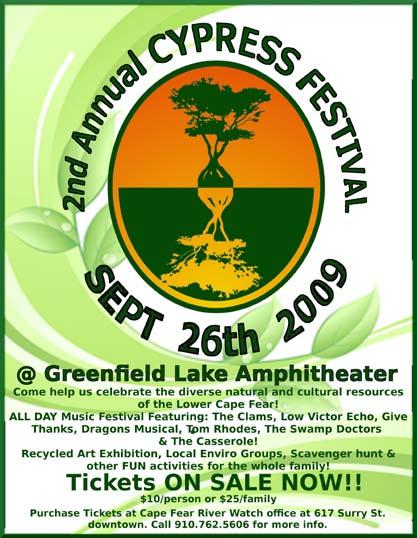
schedule a pick-up time by contacting the Brunswick Soil & Water Conservation District located at the Brunswick County Government Center on 10 Referendum Drive. Call (910)253-2830.
New Hanover Soil & Water Conservation District will continue its monthly barrel sale, where barrels are available on a first-come, first served basis the second Thursday of each month at the New Hanover County Government Complex. Call (910)798-6032 or email rain@nhswcd.org for details.
Brunswick County residents may pre-order barrels and 910.790.3376
Choice Caregivers, Inc.
Wrightsville Beach has a new farmers market Mondays from 8 a.m. until 1 p.m., on Old Causeway Drive across the street from the former Middle of the Island restaurant. Easy parking; fresh produce, flowers, baked goods and more.
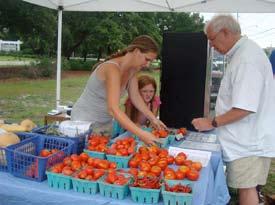
Green Acres Farm in Wake County is looking for volunteers of all ages. Contact Margaret Bowen or Aaron Dickey if you’d like to participate in organic farming. Visit them at the Wrightsville Beach market on Mondays or call (910)279-4161 or (910)443-6391.
Federal Point Farm is a new farm near Monkey Junction, which will offer community garden plots for rent, starting September 1. They sell produce, cut flowers and plants at the Riverfront Farmers Market Saturdays from 8–1. Contact them directly or at federalpoint@bellsouth.net for details. Margaret Shelton, owner of Shelton Herb Farm, attended Wild Herb Weekend 2009, the annual herb conference in Valle Crucis.
artistic recycling and reuse
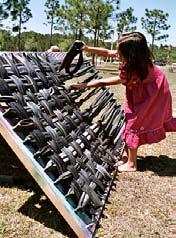
Quilters by the Sea Guild Promotes Re+Ewes

Quilters love a challenge, and members of Quilters by the Sea Guild of Wilmington are no exception. The theme of this year’s quilt challenge was to be environmentally friendly and see how generations before us used their resources. Every entry was required to incorporate part of a previously used garment, and participants were encouraged to shop at local thrift shops for material.
“Kermit’s Rebus,” an original design by Mary Ann Kotas, won second place. Kotas interpreted the theme in the form of a rebus, where words contain pictures: Re + deuce, Re + ewes, Re + cycle.
The first-place winner was “We’re in Stitches” by Carolyn Baker. Not only was her item made from a shirt she found at a resale shop, but she gave it a new life by converting it into a wall hanging with pockets to hold her quilting tools in her quilt room.
After-School Garbage Art Guild for Kids!
Join Dixon Stetler to learn a new way to think about recycling. Her After-School Garbage Art Guild projects for children involve weaving, painting, performance art, public collaborations, mosaics, sculpture, and assorted other messy fun cool stuff made with recycled materials. Guild kids will end the session with a real art exhibition and reception at Wabi Sabi Warehouse.
Classes will be held
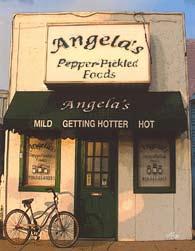
September 22–December 17 from 3:45–5:00 p.m. at Independent Art Company’s Wabi Sabi Warehouse, 19 North 9th Street, your choice of Tuesdays, Wednesdays, or Thursdays. Class is limited to 5 students ages 8–13; Tuition is $350. To register, email Stetler at dixonstetler@gmail.com.

Green Art on Exhibit
Greg Patch creates artwork of beeswax and natural (non-toxic) pigment paints. His work is on display at ArtExposure in Surf City as part of a group show of member artists through September 6. His work is also available at Sapona Green Building Center on 17th Street in Wilmington.
For more information, visit his Web site at www.greenartstudio.com or call 910-616-9930.
your ecological house™
The Battle of the Lawn
by Skip WenzMy father, a Korean war hero and later an E.R. surgeon, won many battles and lost few. Perhaps that’s why his Pyrrhic victory in the Battle of the Lawn stands out in my memory.
Fought on the Fields of Fargo’s Suburbs (in North Dakota) from the 1960s to the 1980s, the protracted conflict pitted a determined, crew-cut, retired Army Captain—armed with an arsenal of chemical weapons—against the relentless Forces of Nature. It began when we moved to a new suburb, and Dad joined a Coalition of developers and neighbors who conspired to remake nature in their own image—square, cropped and predictable in its perpetually green uniformity.
The Coalition was the aggressor. It bulldozed a vast field of hearty, well-adapted prairie grass and wildflowers south of town and built homes in the barren dirt stripped of its topsoil. To secure against a counterattack by the prairie “weeds,” the occupiers laid sod rolls of domestic lawn over the dirt.
The presumption, reinforced by the landscaping contractor, was that with a little water and fertilizer, the new grass would set roots into the compacted soil and maintain its lush appearance indefinitely.
It took about two weeks for Dad’s first lawn to start dying. It was mid summer, and the prairie sun beat down mercilessly on the turf. Although he watered generously every morning, the grass’s lush green blades turned steadily brown—like the prairie grass in the fields beyond the development. He started watering at night as well. (Once he left the water on all night, and it found its way into our new basement.) But bigger and bigger patches of the lawn turned brown—and stayed brown.
Copious quantities of fertilizer and growth hormones were applied. Herbicides poisoned upstart native flowers and pesticides were added for good measure. Most of the chemicals washed right through the turf and wound up in the nearby river.
The landscaper was called. The next spring, as the brown prairie grass entered its green cycle, Dad’s original lawn was dug up and replaced. Automatic sprinklers were installed. More chemicals and a new seed mix were added. And the lawn was mowed and mowed and mowed, so it would “grow better.”
Eventually the new lawn did “take,” and struggled on for a few years before being replaced again. But it only “greened up” briefly after it was watered and fertilized. And we never used it. Never played on it, never sat on it. It was there to look at, and it looked exactly like every other lawn on the block.
much per acre as we use on agricultural crops—at an annual cost of $700 million. These pesticides find their way into the water table and food chain, and many are toxic to beneficial insects, aquatic organisms, fish and birds. Pesticides affect humans too, especially children (and pets) that play on recently sprayed lawns.
Lawnmowers consume 58 million gallons of gasoline annually, and a lawnmower can create as much pollution in an hour as a car does traveling 20 miles. To that we add the pollution from gas-powered leaf blowers which produce much more carbon monoxide and particulate matter than cars do.
So if America is willing to devote a seemingly endless stream of resources and absorb untold environmental casualties, it can temporarily prevail in the Battle of the Lawn—but it can never win the War. Unnatural environments can only be maintained at a high price—one we can no longer afford. In my next column, I’ll explore some alternatives to growing lawns on the precious soil around your ecological house.
© Philip S. Wenz, 2008
Cultivating Earth-Friendly Gardens
Sandy & Andy Wood
Hampstead, North Carolina
910-270-9451
habitats@ymail.com
I recalled the Battle of the Lawn when I encountered some disturbing statistics. A recent NASA satellite survey reveals that we grow more lawn than we do food. It’s our nation’s largest single crop, covering about 40,400 square miles of the U.S., an area the size of Kentucky. Each year we spend about $29 billion—1,200 dollars per U.S. household—maintaining it.
Every 1,000 square feet of lawn soaks up 10,000 gallons of water per year—50 to 70 percent of our increasingly scarce, potable, residential water supply.
We spray 67 million pounds of synthetic pesticides on our lawns—three times as
Philip S. (Skip) Wenz is a freelance writer specializing in ecological design issues. He was a general contractor, residential designer, teacher and writer in the San Francisco Bay Area. In the early 1990s he founded, and for ten years directed, the Ecological Design Program at the San Francisco Institute of Architecture. He also teaches “Creating Your Ecological House,” at Berkeley’s Building Education Center and wrote the book, Adding to a House (Taunton Press, 1995). Skip now lives with his wife, Pam, in Corvallis, Oregon and divides his time between various writing projects and retrofitting his older home to be more environmentally friendly. He may be reached by email through his Web site at www.your-ecological-house.com.
shorebirds
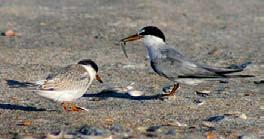
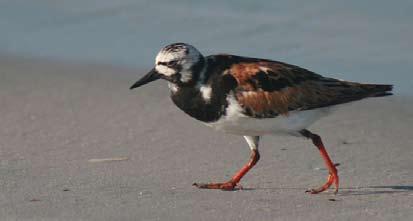
Shorebird nests are simple scrapes in the sand. When walking near a colony it is a good idea to watch where you are going very carefully. Some shorebirds only hatch one or two eggs, so each one is precious. Shorebirds eggs are cryptically colored, and made so to blend with the sand. Pictured above are Least Terns that have recently hatched. The Least Tern is considered a species of concern in many states due to loss of habitat, mainly caused by humans using the beaches for recreation.
Photos taken on the South end of Wrightsville Beach demonstrate how fragile shorebird nests are, and how well camouflaged the chicks are in the sand.

These Black Skimmers are nesting on the North and South ends of Wrightsville Beach, and in surrounding areas. Their nests are feeding grounds for the Red Fox, which is not a native North Carolina species, but was introduced by English settlers in the 1800s. There are many Red Foxes located throughout the islands around Wrightsville, and they decimate nesting shorebird and turtle eggs.

A Black Skimmer catches small fish at the North end of Wrightsville Beach by skimming the water with its lower beak. Skimmers are summer residents on the North Carolina coast, coming to breed and staying from April until October. They prefer to nest in colonies on coastal beaches, or on dredge spoil islands like those around Wrightsville Beach. Skimmers winter in South Carolina, Georgia and Florida.
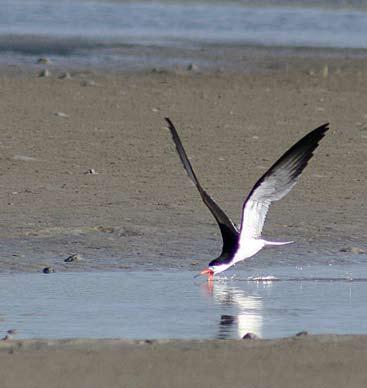
Pedaling for Peanuts
More than 55 mountain bike enthusiasts braved a scorching hot day at Blue Clay Bike Park to participate in the second annual Pedaling for Peanuts mountain bike race. A family-friendly fundraiser for the Full Belly Project (www.fullbellyproject.org), the event surpassed its goal of raising $1000 for the nonprofit.
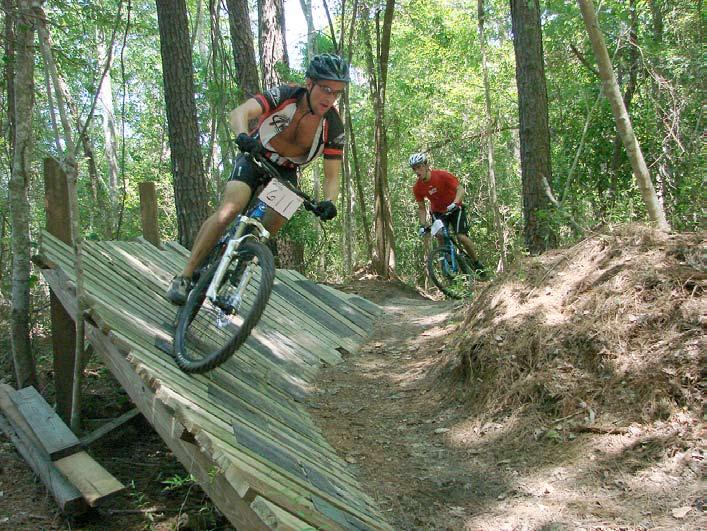
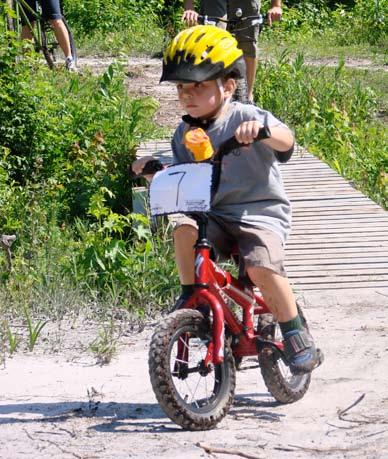
The race is the brainchild of Race Director Austin Fenwick and Gwenyfar Rohler. It was organized with the help of members of the mountain bike division of Cape Fear Cyclists, who are always on hand to help clean the trails in preparation for the event and provide volunteers on race day. The names of the race categories prove this activity was designed to be enjoyed by cyclists of all sizes, ages, and endurance levels. You can compete as a tot (through age 5), as a kid, or as a youth. There are categories for the over-forty and the overfifty folks. There are races for weekend warriors and beginners. Race lengths range from a short loop to a course of 12, 18, or 24 miles. Top three finishers in all categories win prizes, provided by locals. Blue Clay Bike Park, site of the race, is a popular New Hanover County Park.
Pedaling for Peanuts has a Web site (www.pedalingforpeanuts. com) linking to resources for everyone from mountain bikers, to casual riders, to urban commuters. It links to Cape Fear Cyclists cycling club (www.capefearcyclists.org) and to www.sirbikesalot.com, where Erol Caglarcan, A.K.A. “Sir Bikes-a-Lot,” posts information to help cyclists. A long-time mountain bike enthusiast, Caglarcan provides updates on local bike trails, bike maps, and area bike rides.
Race entry number 7, three-year-old Turner Caglarcan, negotiates the modified loop around the parking lot created for competitors in the “Tots” category. All Tots completed the course, and all won prizes. Turner likes to ride his bike almost every day, and enjoys Sunday bike ride outings with his family. He is the son of the legendary Sir Bikes-aLot (Erol Caglarcan).
